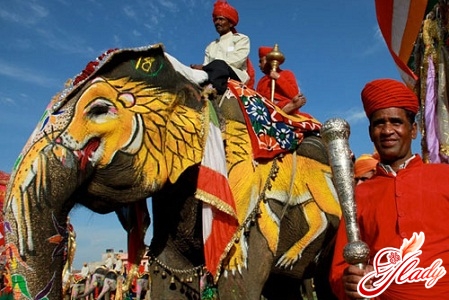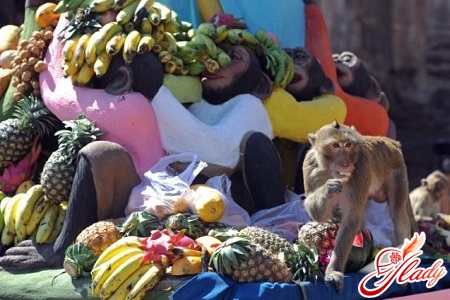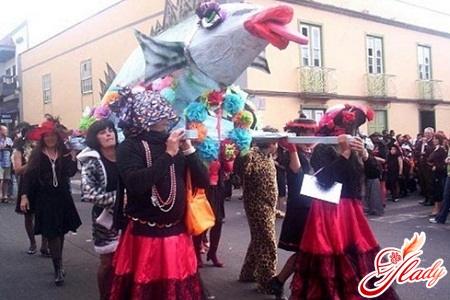 Unusual holidays… How many events have youcan you remember when this phrase is mentioned? Let's count together. Smiley Day, World Blonde Day, April Fool's Day, all sorts of carnivals that are so similar to Maslenitsa, "thank you" day. Perhaps someone will be able to add a few more dates to this list, but in fact there are many more. And each of these holidays, if it cannot become one of your favorites due to its exoticism, can certainly raise your spirits or, at the very least, provide an opportunity to be surprised once again by the diversity of traditions. And believe me, there is a lot to be surprised about! Let's leave it to psychologists and political scientists to figure out how exactly we differ from each other. Let's look at how we are similar. Holidays can help you see this, since they erase social and political boundaries and make us smile at each other. And a smile and a good mood can rightfully be called the most universal language of communication. And this despite the fact that some holidays are so unique that it is simply impossible to find an analogue for them in the culture of another nation. But, as they say, there are more holidays - good and different ones! It is about them that we want to tell in our article.
Unusual holidays… How many events have youcan you remember when this phrase is mentioned? Let's count together. Smiley Day, World Blonde Day, April Fool's Day, all sorts of carnivals that are so similar to Maslenitsa, "thank you" day. Perhaps someone will be able to add a few more dates to this list, but in fact there are many more. And each of these holidays, if it cannot become one of your favorites due to its exoticism, can certainly raise your spirits or, at the very least, provide an opportunity to be surprised once again by the diversity of traditions. And believe me, there is a lot to be surprised about! Let's leave it to psychologists and political scientists to figure out how exactly we differ from each other. Let's look at how we are similar. Holidays can help you see this, since they erase social and political boundaries and make us smile at each other. And a smile and a good mood can rightfully be called the most universal language of communication. And this despite the fact that some holidays are so unique that it is simply impossible to find an analogue for them in the culture of another nation. But, as they say, there are more holidays - good and different ones! It is about them that we want to tell in our article.
Holi - a holiday of all colors of the rainbow
 If we talk about unusual holidays, then let's startbest of all with the brightest of them. Every year, India, already stunning in its color, turns into a place of real riot of colors and fun. At the end of February or the beginning of March (the beginning of the holiday depends on the day of the full moon, calculated according to a special calendar), Indians go out into the streets and throw colored powder at each other or pour colored water. They do not do this out of a desire to be naughty; the holiday has a religious basis. True, during its existence, legends explaining the reason for such revelry have become too numerous for us to understand them. One of the legends tells that the god Krishna, about whose immortal love for Radha many legends have been composed, came to his mother with a question why his skin was so different from the skin color of his beloved. And he complained that it was this difference that prevented them from becoming the most perfect couple of lovers. To which the wise Yashoda advised him to sprinkle his beloved's face with herbal powder and see how her complexion changed. Since then, young men and women in love have been sprinkling each other with colored powder. But it doesn't end with just sprinkling colored powder. The whole world knows "talking" Indian dances. So, there is a whole ritual dance in which young people apologize to each other and confess their affection. Now imagine this dance apology and confession on the scale of an entire city! And an entire country?! Isn't it a stunning sight!
If we talk about unusual holidays, then let's startbest of all with the brightest of them. Every year, India, already stunning in its color, turns into a place of real riot of colors and fun. At the end of February or the beginning of March (the beginning of the holiday depends on the day of the full moon, calculated according to a special calendar), Indians go out into the streets and throw colored powder at each other or pour colored water. They do not do this out of a desire to be naughty; the holiday has a religious basis. True, during its existence, legends explaining the reason for such revelry have become too numerous for us to understand them. One of the legends tells that the god Krishna, about whose immortal love for Radha many legends have been composed, came to his mother with a question why his skin was so different from the skin color of his beloved. And he complained that it was this difference that prevented them from becoming the most perfect couple of lovers. To which the wise Yashoda advised him to sprinkle his beloved's face with herbal powder and see how her complexion changed. Since then, young men and women in love have been sprinkling each other with colored powder. But it doesn't end with just sprinkling colored powder. The whole world knows "talking" Indian dances. So, there is a whole ritual dance in which young people apologize to each other and confess their affection. Now imagine this dance apology and confession on the scale of an entire city! And an entire country?! Isn't it a stunning sight!
Cocktail reception for monkeys
The most unusual holidays in the world are dedicated entirely tonot to people. For example, in Thailand and India - the culture of these countries is full of exotic reasons and ways of celebrating - they arrange a real banquet for monkeys. And they approach this holiday, it must be said, with all seriousness. After all, they honor these funny animals for a reason. This holiday, like many others, has a centuries-old history and its own justifying legend. God Rama with his assistant and friend Hanuman, the god of monkeys, tried for a long time and in vain to defeat the legions of evil on earth. Until Hanuman called his army. The victory over evil was complete and unconditional. Hanuman was given the lands where the city of Lopburi is now located. And since then, the monkeys have been honored with their own banquet every year. At the end of November, 2 tons of fruits, rice and sweet drinks are beautifully laid out on a huge seven-meter table for monkeys, according to all the rules of table setting. And the funniest thing is that the drinks are poured into glasses. The monkeys are very responsible about their status as the heroes of the occasion and almost humanly primly begin their meal. Until it comes to the drinks. Either they have time to ferment, or the well-fed monkeys forget about "manners", but at the end of the holiday, complete revelry and fun begins with the smashing of dishes and the nearest unwanted faces. Very human, isn't it?
Funeral March ... sardine
And this unusual holiday comes from the hotSpain. As it turns out, the Spanish are generally a very cheerful people. On New Year's Eve, they divide the ears of a dead donkey, and on Shrove Tuesday they bury a sardine. And not just bury it, but with funeral marches, widows and "sobs". This holiday was captured by the great Francisco Goya in one of his paintings. True, there is no smell of a sardine on the canvas of the great artist, as they say, but the wild fun is conveyed vividly and colorfully. Why do they bury fish with such honors, you ask? It's very simple. At the beginning of the eighteenth century, during the reign of King Carlos III in Spain, fish for the royal kitchen was slowly transported by carts. And there were cases when the fish could not withstand the hardships of a long journey and spoiled. Once, the "wise and generous" king, having learned about another "unsuccessful" delivery, decided to treat the residents of Madrid with second-freshness fish. It happened right during the carnival. Apparently, Carlos III had literate nobles in his entourage who, in order not to provoke the people's wrath, added Spanish wine to the "aromatic" treat. It was rolled out onto the streets in barrels. And the Spaniards, contrary to all the myths about their irrepressible temperament or simply not wanting to sin on the eve of Lent, did not start a revolution, but, having dressed up in a manner appropriate for a funeral, buried the unfortunate martyr-sardine. Today, the holiday has almost not preserved the primness of 18th-century Spain. It is more like a carnival with traditional fun and fiery dances. True, the performance with the sardine "coffin" is still held today. The funeral procession is accompanied by mourners, disguised mustachioed men, from whom the most "inconsolable" is then chosen. She is appointed the honorary widow and queen of the holiday. The sardine model is burned at the end of the festival and the ashes are buried in the ground. All according to tradition.
A Japanese is naked!
All those who thought that the holidays were unusualworld - the lot of temperamental southerners, do not know about the day of the naked man. This holiday will appeal to lovers of male striptease. And the most surprising thing is that this holiday is held in Japan. In the country of reserved men and obedient women. But we are talking about unusual holidays, and therefore - down with stereotypes! This holiday is held on the coldest day of February, and everything would be fine, but on this day men have to run almost naked through the streets, take an ice-cold shower and make a circle in one loincloth around the temple. One consolation: the prudent Japanese give their naked heroes hot sake to drink and do not let them stand idle. After all the ablutions in icy water, real fights are arranged. "Hot Japanese guys" meet on an improvised tatami and compete, who will win. Still, the proximity to Mother Russia was not in vain for the Japanese! At midnight, everyone who has decided to take part in the Hadaka Matsuri, as this festival is called, gathers at the doors of the temple to receive an amulet, which the priests throw into the crowd. After this, the festival reaches its climax. A crowd of men in loincloths goes out into the street shouting and singing, and in this crowd of half-naked men, one is completely naked, and it is he who must be touched "for good luck". Of course, if you are lucky enough to find him in a crowd of thousands, you can already consider yourself a rare lucky woman.
Playing snowballs in Spanish
The most generous for the crazy holidays wasSpain. Here you can even bury a sardine. And in Valencia they burn huge papier-mâché dolls at the Fallas festival. But even this was not enough for the temperamental and cheerful Spaniards. They started a custom of throwing ripe tomatoes at each other. It is very similar to the Russian pastime of playing snowballs. Apparently, due to the lack of snow, the Spaniards had to make do with improvised means. The fun in the town of Buñol begins in the last week of August, after the harvest. And the celebration itself includes songs, dances, fairs and fireworks. It would seem that there is nothing unusual, if not for the La Tomatina, which not only Spanish residents but also residents of other countries come to watch and participate in. And it all began with an ordinary fight that took place in the 40s of the last century right at the festival in honor of the patron saint of the city, Saint Louis Bertrand and Our Lady of Protection. The townspeople got so carried away in the heat of the fight that they grabbed ripe tomatoes from the fair stalls and threw them at each other. The police dispersed the fighters. But either they did not forgive each other, or they simply enjoyed throwing tomatoes, but exactly a year later the "fighters" gathered again in the same square. And they brought ripe tomatoes with them. Tomatina has been banned more than once, but the tradition turned out to be so tenacious that the city authorities came to terms with it and now tons of tomato "snowballs" are brought to the Plaza del Pueblo every year. There are about 9 thousand local people in Buñol itself, but there are ten times more fighters. They flock here from all over the country just before the holiday to try their luck and climb the soapy pole in the middle of the square for a ham "jamon". As soon as one of the lucky ones gets a ham, all the fighters are doused with a water cannon, and the tomato massacre begins. There are no right and guilty, friends and foes - everyone is for himself, and the main thing in this tomato war is not to win, but to be a child for a few hours. We were all told in our childhood that throwing food is indecent. Well, at the Tomatino festival it is obligatory. The main thing is not to forget to put on protective glasses and crush the tomato, so as not to give bruises to the "opponents". Zombie march in Texas, mud festival in Japan, orange massacre in Italy, "yogurt festival" in Tibet, beauty contest for elephants in Laos - unusual holidays roll like a wave all over the world. Each of them has its own history, many are unique and unrepeatable. But this, rather, serves as further proof that no matter how different we are, no matter how different nations are from each other, we all have one common desire - genuine joy and a sense of celebration in the soul.









